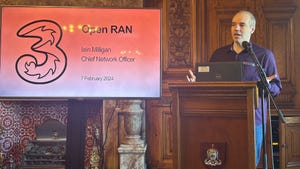Who's Doing What in the CBRS Band?
FCC filings shed light on mix of initial deployment proposals targeting the emerging, shared 3.5GHz band.

A group of Spectrum Access System (SAS) administrators with conditional approval from the FCC (and one that wants to get in on the fun) have filed proposals to the Commission about plans they have in store for the 3.5GHz Citizens Broadband Radio Service (CBRS) band.
The Federal Communications Commission (FCC) still must give the green light for these proposals to go forward. Should they pass muster, initial commercial deployments (ICDs) using an unlicensed portion of that 150MHz-wide band will get underway before the end of the year (the FCC still needs to finalize rules for licensed parts of the CBRS band). The SAS administrators have all developed or are developing spectrum allocation systems to ensure that these new users don't interfere with incumbents operating in that slice of spectrum, including the US Navy. (See Unlicensed CBRS 4G Service Coming Q4 2018.)
Here's a roundup of who wants to get it on with OnGo, the brand bestowed upon the 3.5GHz CBRS band (See CBRS LTE Gets Branded as 'OnGo'):
As reported by Light Reading earlier this week, Federated Wireless filed an application planning participation in initial deployments involving 15 wireless operators, cable operators and tower companies, as well as more than 80 rural carriers. The anticipated scope will include nearly 16,000 sites in 47 states. (See Federated Wireless Sets Plan for Massive CBRS Band Deployment .)
CommScope Inc. 's Comsearch unit said its initial, proposed work in the CBRS band will last a minimum of 30 consecutive days, providing data that will help the FCC "reasonably predict" that the company's SAS will operate reliably in compliance with FCC rules. CommScope also wants to demonstrate interoperability with a group of other SAS companies that at "minimum" would include Amdocs, Google and Sony.
Update: Among specific activities, AT&T Inc. (NYSE: T) announced recently that it has picked Samsung Electronics America and CommScope for its first "5G-ready" CBRS platform. AT&T will use CBRS-compliant radios and basestation equipment from Samsung and will use CommScope as its SAS provider as it prepares for lab tests early next year and for commercial rollouts by late 2019. (See AT&T Picks Samsung, CommScope for CBRS Rollout.
Key Bridge Wireless wants to conduct ICD testing for at least eight weeks (but no more than ten weeks), believing that's enough time "to produce a substantive and meaningful report for the Commission." Though Key Bridge is a "neutral operator" and will support CBRS products from multiple suppliers, it has hooked up with Nokia Corp. (NYSE: NOK) (for the wireless infrastructure) for its initial commercial deployment effort, and will use Amazon Web Services Inc. for its cloud-hosted SAS platform.
Amdocs Ltd. (NYSE: DOX) wants its solution for the proposal, called the CBRS Under Test (CUT), to run for a minimum of 30 consecutive days -- enough for it to complete its ICD test report, which will be into the Commission for final review one month after completion.
Google (Nasdaq: GOOG) also wants to partner up with equipment vendors, service providers and other SAS administrators, but several details were not disclosed in its publicly available redacted filing. However, it noted that there's no plans for non-Google employees to be granted direct access to the SAS, but FCC personnel (working with Google people) will be able to monitor the work.
Fairspectrum LLC submitted a proposal for short-term, limited geographic deployment in the band. The company, a subsidiary of its Finnish parent, said it has applied to become an SAS administrator in the second wave.
Ruckus Networks, now a unit of Arris Group Inc. (Nasdaq: ARRS), reiterated that it received the FCC's first CBRS Device (CBSD) authorization on September 6 for Q710 and Q910 small cell products. (See Ruckus Networks Scores CBRS Certification.)
Among other filings entering the FCC docket this week, the National Public Safety Telecommunications Council acknowledged there's been a significant amount of work done in the band ahead of this initial commercial deployment phase, but stressed that it's too early for the FCC to report to Congress that results of rules for the 3.5GHz band "are either a success or a failure" when it comes to managing that shared spectrum.
"Although some testing has been conducted, any significant operation of CBRS devices is yet to occur," because there's still a lack of real-world results to analyze, the NPSTC said. It added that it's also not valid to assume that tests in the 3.5GHz band would "have validity for sharing in other bands." At least not yet.
The NPSTC also shed some light on the "exclusion zones" for the band, which are largely confined to run along the edges of US coastlines where Navy ships operate. Citing an NTIA report, the agency said there are 27 ground-based radar sites at military installations that must be protected, and a recent article in Defense News indicated that the US Navy had 280 ships as of February 2018, with plans to expand the fleet to 326 by 2023.
Meanwhile, the CTIA stressed that the 2015 3.5GHz FCC Order didn't contemplate if that band would be suited for 5G, and therefore supports "targeted reforms" that would look into it.
�— Jeff Baumgartner, Senior Editor, Light Reading
About the Author(s)
You May Also Like












